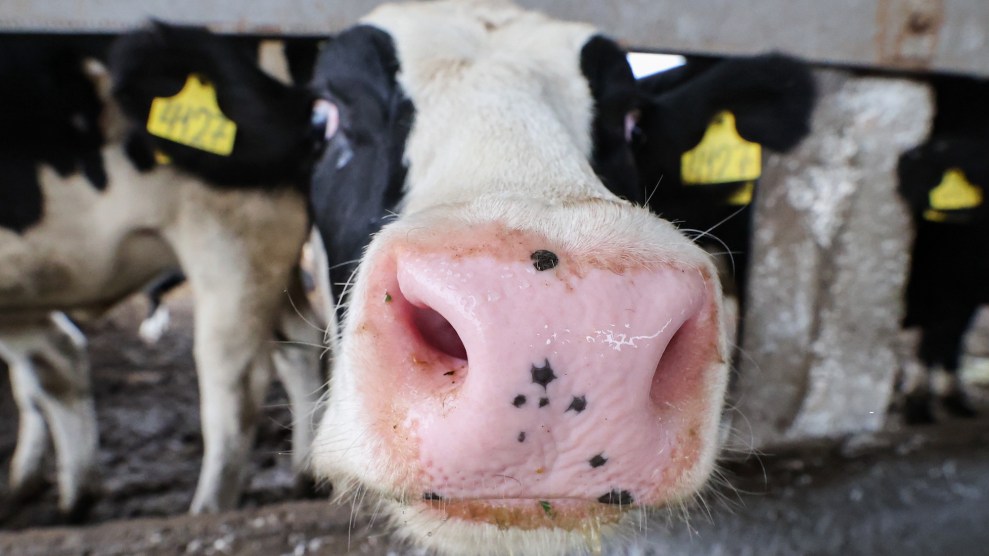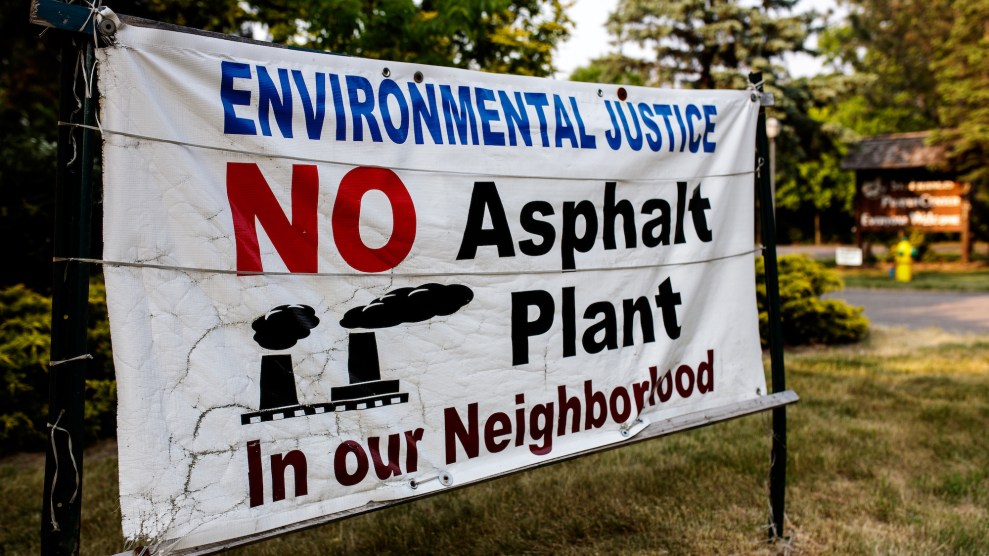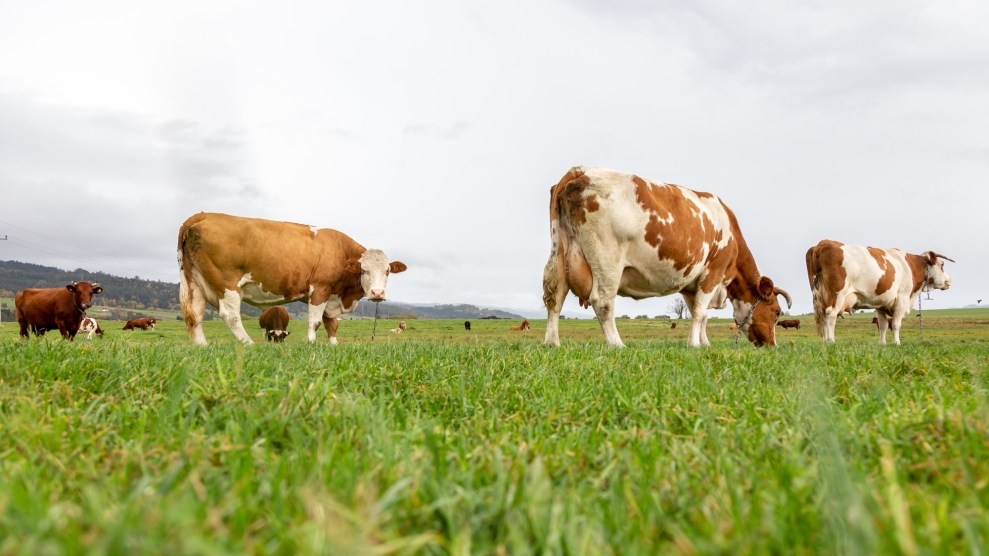
Alexander Polegenko/TASS/Zuma
This story was originally published by Inside Climate News and appears here as part of the Climate Desk collaboration.
Anyone feeling compelled to look into a bill passed recently by the House of Representatives will see some familiar language.
It may seem wonky—the concern of agriculture or climate policy geeks. But the language relates to one of the country’s biggest sources of an especially powerful climate-warming greenhouse gas: methane from cows. And right now, reducing methane is the world’s best, most expedient strategy for quickly staving off atmospheric calamity.
Written into a must-pass spending bill the House approved in November, the provision prevents the government from funding a law that requires big livestock farms to report how much methane their operations emit. Every spending bill Congress has passed in the last 14 years has contained similar disabling language.
In effect, while Congress has said it wants big farms to report some of their methane emissions, it has also said it won’t give regulators money to do that.
The Environmental Protection Agency (EPA) has, for decades, struggled to regulate agricultural pollution under the country’s bedrock environmental laws, as the livestock industry—and the powerful farm lobby—and their allies in Congress win exemptions from regulation in legislation and court decisions.
“It speaks to their political power,” said Patty Lovera, a policy advisor for the Campaign for Family Farms and the Environment. “Regulation is a third rail.”
But this long-standing “agricultural exceptionalism” is starting to come under the microscope as it becomes urgently and increasingly clear that cutting emissions from all sectors of the world’s economies is critical to meeting climate targets.
At the recent United Nations climate summit in Dubai, more than 150 countries pledged, albeit voluntarily, to cut emissions from their agriculture and food systems, including from livestock, and six of the world’s largest dairy companies announced they would begin reporting their methane emissions publically.
Reporting will be critical to cutting global methane emissions, because, advocates argue, you can’t reduce what you don’t measure.
Agriculture, largely livestock production, accounts for about 37 percent of global methane emissions. In the United States, agriculture accounts for roughly 11 percent of greenhouse gas emissions. About 25 percent of that comes from cow burps that release methane, another 10 percent or so from the methane generated by livestock manure, and about 50 percent from nitrous oxide emitted when fertilizers are applied to crops. Corn, the nation’s largest crop, is especially fertilizer-intensive; about 40 percent of the crop grown by US farmers is fed to livestock.
The livestock industry points out that cattle produce only about 3 or 4 percent of the US’s greenhouse gas emissions. But that percentage still adds up to the overall greenhouse gasses emitted by some countries, critics counter. (According to the EPA, emissions from cow burps and manure in the U.S. produced 278 million metric tons of carbon dioxide equivalent in 2021. By comparison, the entire country of Spain produced 289 million metric tons that same year.)
While methane emissions from other sectors of the American economy are going down, methane from livestock, particularly manure, is going up. Emissions from manure have climbed more than 60 percent between 1990 and 2021.
An Inside Climate News analysis of the EPA’s Inventory of US Greenhouse Gas Emissions found that, in 2020, cows emitted more than twice as much methane from their burps and manure as all of the country’s oil and gas wells.
Yet in the United States, the world’s biggest producer of beef cattle, the second-biggest producer of milk, and third third-biggest producer of pork, regulatory agencies don’t measure livestock methane very well, or in some cases at all, critics say.
To estimate emissions from large livestock facilities, the EPA’s inventory relies on data from states, which is often incomplete.
“We do have emissions estimating methodologies, which you can use if you know the number of animals and which manure management strategy is being used,” said Chloe Waterman, a senior program manager at the environmental advocacy group Friends of the Earth. “But we don’t even know how many animals are on these farms.”
In 2007, California’s Democratic senators, Barbara Boxer and Dianne Feinstein, attempted to address one of the knowledge gaps by securing $3.5 million for the EPA to establish a greenhouse gas registry for “all sectors” of the economy. The push by these and other Democratic senators began in the same year that the Supreme Court decided the EPA was legally required to regulate greenhouse gas emissions.
With the funding, the EPA ultimately launched the agency’s Greenhouse Gas Reporting Program in 2009. The program—distinct from the agency’s emissions inventory—was intended to obtain data from individual sources of greenhouse gas emissions, at the “facility level,” that emitted more than 25,000 tons of greenhouse gasses a year. About 13,000 facilities, including somewhere between 50 to 100 large livestock facilities, would be covered under the law.
Despite the fact that cow belches—or enteric emissions—are the biggest source of methane from livestock, the EPA did not include these emissions in its original or finalized proposal for the program, saying that “practical reporting methods to estimate facility-level emissions for these sources can be difficult to implement and can yield uncertain results.” The program only required facilities to report emissions from their manure management systems.
At the time, the farm lobby was expressing its alarm about a perceived EPA proposal to tax methane from cows and was waging a campaign to ensure that Congress didn’t “tax cow farts.” (The EPA had discussed livestock regulations in a technical report, but never proposed taxing livestock emissions.) Congress was also working to craft legislation that would create a mandatory cap-and-trade system to reduce the country’s emissions, which the farm lobby ultimately worked to defeat.
“We heard a lot of ruckus about a cow tax,” Lovera said. “It was the end-of-days, a full-court press. In this anti-regulatory culture war, the various commodity groups are incredibly good at narratives, and this is a really classic example.”
The already regulation-wary agriculture industry, which had successfully avoided most environmental rules thus far, saw the reporting program as another attempt at regulation.
“Once we’re reporting our emissions, is the next step that we will be regulated?” said Jonathan Banks, a senior climate policy advisor at the Clean Air Task Force. “I think that was the fear within the agriculture sector.”
Even though only a small number of facilities would fall under the reporting program and enteric emissions weren’t included, farm-state lawmakers ensured that the reporting requirements would never touch farm country anyway. The American Farm Bureau Federation called the reporting requirements “elaborate and burdensome” and expressed concern that reporting would be a precursor to regulation.
In anticipation of the reporting program, US Rep. Tom Latham, a Republican from Iowa, introduced an amendment to an appropriations bill in the spring of 2009 that said no funds approved by Congress could be allowed to pay for any provision “if that provision requires mandatory reporting of greenhouse gas emission from manure management systems.”
“It will do nothing to improve the environmental health of rural America,” Latham said on the House floor that year.
The language made it into the year’s final budget bill and has been included every year since. In 2022, after Democrats stripped the language from the bill, Republicans successfully negotiated the provision back in.
The National Pork Producers Council celebrated the success of Latham’s amendment, saying in its annual report that it backed “a measure that stops EPA from implementing in fiscal 2010 any provision requiring livestock operations to report greenhouse gas emissions from manure management systems.” Lathan received more campaign money from agriculture than any other sector that year.
Iowa is, by far, the largest hog-producing state in the country, and while hogs don’t generate enteric emissions, the confinement facilities they’re raised in have massive lagoons and waste systems that generate large amounts of methane.
More recently, Sen. Joni Ernst, also a Republican from Iowa, and Sen. John Thune, a Republican from South Dakota, introduced a bill that would prevent any funds from the Inflation Reduction Act, the Biden administration’s sweeping climate-focused bill, to be used to monitor methane from livestock.
The annual and occasional legislative efforts to block the EPA from getting basic information about how much greenhouse gas emissions are coming from American farms come as billions of dollars are flowing to the nation’s cattle and dairy producers.
Various government agencies, including the US Department of Agriculture, have offered nearly 100 different financial incentives for dairy and cattle farmers to build anaerobic digesters and other infrastructure to capture methane coming from their operations.
In November, advocacy groups wrote to Agriculture Secretary Tom Vilsack, asking the agency to stop sending millions in IRA funding to build digesters, arguing that the funds would have the effect of expanding methane-intensive farming.
They also point to recent research showing that digesters, which are intended to capture methane, may, in fact, leak quite a bit more methane than the EPA assumes in its calculations.
Studies, based on remote sensing, have gauged that a considerable amount of methane may be leaking from digesters. But it’s unclear exactly how much because the EPA and state regulators lack the regulatory tools to measure the methane emissions in the first place—even as billions of dollars are going toward these operations.
“Getting the facility-level emissions is really important because we see that as methane sensing technologies improve, they’re casting doubt on EPA’s accuracy in measuring the effectiveness of methane digesters,” Waterman said. “But nobody’s monitoring at the facility level.”
“I don’t want to undermine the evidence that EPA has put out about methane,” Waterman added. “But we should be doing facility-level reporting and we have a lot of work to do when it comes to comprehensively and accurately measuring methane emissions.”















